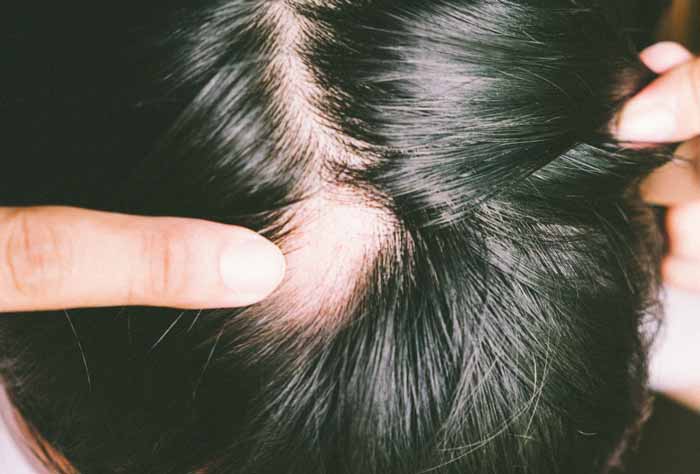Alopecia Areata
Alopecia is a generic term used for hair loss. Alopecia areata is a common skin condition that affects the hair and causes patchy hair loss. It can occur in individuals of any age and gender, but usually seen in children and young adults. It is most commonly seen over scalp, but can affect any hair-bearing site of the body like eyebrows, eyelashes, beard and underarms.
Alopecia areata is an auto-immune condition where the immune system attacks the hair follicles, leading to hair loss. It is not a contagious disease and will not spread from one person to another. However, it tends to occur more in those with a family history of similar bald spots. There is no known vitamin or dietary deficiencies related with such hair loss.

Symptoms of alopecia areata:
It can start as a sudden single smooth patch or multiple patches of hair loss. These patches can merge to form larger patches or can lead to total loss of scalp hair. There is no associated redness, scaling or rash of the affected area. It is usually a painless and non-itchy condition, but some people complain of slight tingling, pain or itchiness in the areas before the hair falls off. This condition tends to spare the white hairs and sometimes white hairs may be found over these patches. Thus, entire scalp turning white overnight could be a symptom of alopecia areata due to loss of the dark hair. Small tapered hairs called as exclamation mark hairs could be seen at the edges of alopecic patches. These are narrower towards the scalp and broader towards the tip. There is no systemic involvement and the affected individual is otherwise healthy.
Nails are sometimes affected and present as nail pits and ridges or brittle nails and nail destruction in severe cases.
The effects are mostly psychological and can hamper the individual’s quality of life severely.
Types of alopecia areata:
Manifestation of alopecia areata is different amongst individuals. The extent of involvement cannot be anticipated in the early stages. There can be various types of alopecia areata depending on the area of involvement of hair loss. Over the scalp, it presents as smooth, coin shaped or round areas of hair loss, which can merge to form larger bald patches. (Patchy alopecia – single or multiple patches)
In some, hair loss can occur in the occipital or back portion of the scalp. (Ophiasis) In others, it may cause diffuse hair loss (diffuse alopecia) or total loss of scalp hair (alopecia totalis).
In severe cases, it can cause total loss of all body and scalp hair (Alopecia universalis).
Severe cases of alopecia like alopecia totalis and alopecia universalis are sometimes associated with other autoimmune diseases like thyroid disease, vitiligo, lupus and diabetes.
Hair regrowth and prognosis:
Alopecia areata usually has a good prognosis and hair regrowth occurs without leaving any scar. In cases with a single patch or very few patches or in very young children, hair can sometimes spontaneously regrow over the bald patch without any treatment. With treatment, hair regrowth usually occurs over a span of few months or years. Once hair regrowth has occurred, stoppage of further episodes cannot be guaranteed.
Complete and favorable response is more likely in individuals having a late age of onset, no concomitant nail changes, no family history and less area of involvement. Individuals having on current atopic dermatitis, early age at onset, nail involvement, ophiasis pattern and extensive area of involvement tend to have slower hair growth, incomplete response to treatment and more chances of relapses. Those with alopecia totalis and universalis do not have full regrowth and usually require some camouflage technique to deal with their condition.
Treatment:
Alopecia areata is not a curable condition but it can be treated with various modalities. Treatment response varies with the type of alopecia. Treatment options include creams, injection, phototherapy as well as oral medications.
Corticosteroids: They can be injected locally over the bald patches or applied as creams to target the hyperactive immune system.
Immunotherapy: Immunomodulators and contact allergens can be used locally to subdue the immune response causing hair loss.
Minoxidil lotion may sometimes boost hair growth.
Oral medications: For those with severe and progressive alopecia, oral medications are needed to halt the disease process and help growth of new hair.
Phototherapy: Psoralens are photosensitive chemicals, which get activated on sun exposure. It can be applied as a solution over the affected area and then exposed to the sun o target the localized immune system responsible for causing alopecia areata.
Microblading: For those having alopecia areata of the eyebrows, microblading can be done. It is a micropigmentation technique where pigment is deposited in the skin in strokes and resembles hair. Camouflage with wigs
Self-care: Protection of eyes with false lashes or glasses when one has lost their eyebrows. Application of antibiotic ointment in case there is loss of nose hair.




